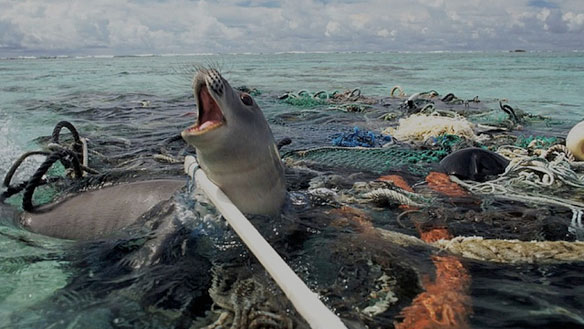
“When plastic ingestion occurs, it blocks the digestive tract, gets lodged in animals windpipes cutting airflow causing suffocation, or fills the stomach, resulting in malnutrition, starvation and potentially death. Indeed, it is found that debris often accumulates in the animals’ gut and give a false sense of fullness, causing the animal to stop eating and slowly starve to death.” —Captions: © SAF — Coastal Care
Photo source: ©© Tedsgp2
Excerpts;
Marine debris is negatively affecting more than 800 animal species and causing serious losses to many countries’ economies, according to a United Nations report launched December 5th, 2016.
The report, Marine Debris: Understanding, Preventing and Mitigating the Significant Adverse Impacts on Marine and Coastal Biodiversity found that the number of species affected by marine debris has increased from 663 to 817 since 2012.
It also warned that this type of waste, which is mostly made of plastic, is an increasing threat to human health and well-being, and is costing countries billions of dollars each year…
“I hope that this report will provide governments and other stakeholders with the information needed to take urgent actions to address marine debris, one of the most prominent threats to marine ecosystems, and support healthy and resilient oceans as a critical aspect of achieving sustainable development,” said Braulio Ferreira de Souza Dias, the Executive Director of the Convention on Biological Diversity (CBD).
The report was launched in Cancun, Mexico, on the sidelines of the 13th meeting of the Conference of the Parties to Convention, known as ‘COP13,’ where governments and private sector delegations have been gathered since 2 December to discuss, among others, how to integrate biodiversity into policies relevant to agriculture, forestry, fisheries and tourism sectors. The meeting wraps up on 17 December.
Marine debris is usually defined as any persistent, manufactured or processed solid material discarded, disposed of, or abandoned in the marine and coastal environment. Three-quarters of all marine debris is plastic, a persistent and potentially hazardous pollutant, which fragments into microplastics that can be taken up by a wide range of marine organisms.
The most common types of marine debris are: food wrappers, bottle caps, straws, grocery bags, beverage bottles and cigarette butts. Five of these items are made of plastic.
Marine and coastal species – fish, seabirds, marine mammals and reptiles – are affected by marine debris mostly through ingestion or entanglement. According to the report, 40 per cent of cetaceans, and 44 per cent of seabird species are affected by marine debris ingestion. The effect of ingestion is not always understood, as many ingest microplastics – little pieces or fragments that are less than five millimetres in diameter…
Read Full Article, United Nations (12-05-2016)
Global Impact of Debris on Marine Life Studied, Science Daily (02-19-2015)
Nearly 700 species of marine animal have been recorded as having encountered humanmade debris such as plastic and glass according to the most comprehensive impact study in more than a decade…
The Plastic Found In a Single Turtle’s Stomach, Independent UK (03-24-2011)
90 Percent of Seabirds Have Plastic in Their Stomachs, Newsweek (09-01-2015)
By 2050, nearly all seabirds will have plastic in their stomachs. Already, 9 out of 10 of the birds have some of the substance in their digestive tracts. Such are the sobering conclusions of a study published August 31 in the journal Proceedings of the National Academy of Sciences…
Death by Plastic: Is Ocean Plastic Garbage Killing Whales?, Independent UK
From the coasts of California to Adriatic, Tasmania or Normandy, millions of tonnes of plastic debris dumped each year in the world’s oceans, could pose a lethal threat to whales, according to a scientific assessment to be presented at the International Whaling Commission this week. Ingestion of plastic refuse is emerging as a serious cause of disability and death for the large ocean-dwelling mammals…
Fish for dinner? Your seafood might come with a side of plastic; Guardian UK (08-31-2016)
Plastic Contaminates Ocean Sourced Table Salt, Scientific American (10-30-2015)
When researchers analyzed fifteen brands of common table salt bought at supermarkets across China, they found among the grains of seasoning micro-sized particles of plastic. The highest level of plastic contamination was found in salt sourced from the ocean…
People may be breathing in microplastics, health expert warns; Guardian UK (05-10-2016)
People could be breathing in microparticles of plastic, according to a leading environmental health expert, with as yet unknown consequences on health…
Biodegradable Plastics Are Not the Answer to Reducing Marine Litter, UN News Center (11-23-2015)
Widespread adoption of products labelled ‘biodegradable’ will not significantly decrease the volume of plastic entering the ocean or the physical and chemical risks that plastics pose to marine environment, concluded a UN report released today…
The Ocean Is Contaminated by Trillions More Pieces of Plastic Than Thought, IOP Science (12-08-2015)
This new study suggests there are 15 to 51 trillion micro plastic particles (those less than 200 millimeters in size) in the world’s oceans, weighing between 93 and 236,000 metric tons. This is about seven times more than scientists had previously estimated…
U.S. polluting ocean with trash at alarming rate, CBS News
20 countries are responsible for more than 80 percent of the plastic going into the ocean annually. China is the worst, with about 2.4 million tons. The United States is number 20, responsible for about 750,000 pounds…
All Human-Made Objects on Earth Amount to 30 Trillion Tons; LiveScience (12-05-2016)
Plastic Pollution / When The Mermaids Cry: The Great Plastic Tide, Coastal Care ©-2009.
“The unprecedented plastic waste tide plaguing our oceans and shores, can become as limited as our chosen relationship with plastics, which involves a dramatic behavioral change on our part…”

A study reports that as high as 50% of camel deaths are caused by plastic bags’s ingestion…and this was in 1997…— Smeadvisor
“For more than 50 years, global production and consumption of plastics have continued to rise. An estimated 300 million tons of plastics were produced in 2015, confirming and upward trend over the past years, according to a new report by the World Economics Forum, released at Davos in January 2016.
Plastic is versatile, lightweight, flexible, moisture resistant, strong, and relatively inexpensive. Those are the attractive qualities that lead us, around the world, to such a voracious appetite and over-consumption of plastic goods. However, durable and very slow to degrade, plastic materials that are used in the production of so many products all, ultimately, become waste with staying power.
Our tremendous attraction to plastic, coupled with an undeniable behavioral propensity of increasingly over-consuming, discarding, littering and thus polluting, has become a combination of lethal nature…”
” —Captions and Photo: © SAF — Coastal Care








